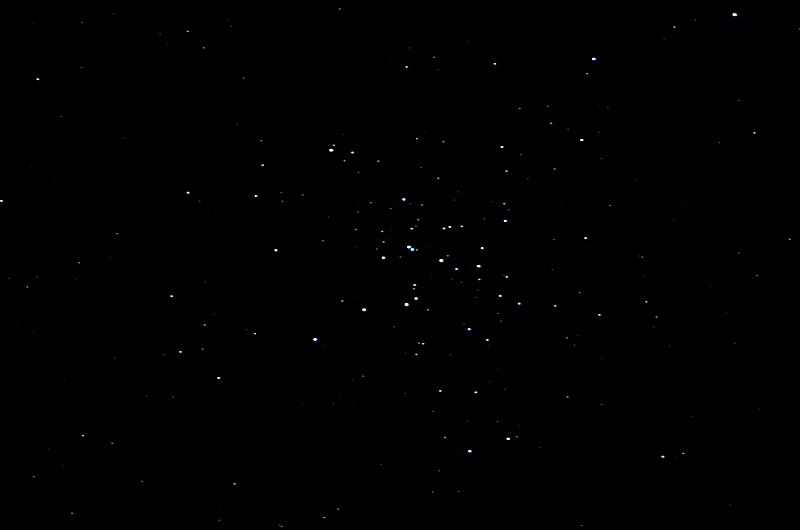Imaging: Moon, NGC7009 (Saturn Nebula), Messier Open Clusters
Posted: 30 September 2014
Clouds returned on Wednesday, 24 September. Heavy rain occurred Friday morning shortly after sunrise. Got 0.5" in 35 minutes. No problems in observatory. As sunset approached on Sunday, 28 September, this pretty bobcat was outside my room:

Click or tap to see a larger version
The sky was finally clear again on Monday, 29 September.
|
Opened: Monday, 29 September 2014, 1826 MST Temperature: 82°F |
Session: 722 Conditions: Mostly clear |
1834 MST: viewed Saturn, then Mars, 83X, both low in the southwest. Then viewed the crescent moon, 83X. Did a lunar tour at 222X. Some nice sights. Set up for iPhone 5s afocal 77X imaging using my modified MX-1 Afocal Adapter. This is the best photo of the moon this night:

Click or tap on image for a larger version
1851 MST: resumed lunar observing, 222X. Also, SYNCed the observatory clock to WWV. The coarse tuning on my old shortwave receiver, purchased in 1978, failed. Fining tuning failed a couple of years ago. Guess it is time to get a new shortwave receiver!
1930 MST: slewed to NGC7009 (Saturn nebula, planetary nebula). It was easily seen at 83X against the moonlit sky. I planned to image it this night. I had previously imaged it on 7 November 2010 (15 seconds, ISO 12800) at prime focus + 2X Barlow Lens. This night I would take 30 second, ISO 800, exposures at prime focus for stacking using Lynkeos. I also tried to view NGC7252 ("Atoms for Peace" Galaxy), which I planned to also image this night. I had previously imaged NGC7252 at prime focus on 11 September 2013 (10 minutes, ISO 6400). Due to the moon and NGC7252's low altitude, I could not view it at 83X. At 2015 MST, I began preparing for imaging so that when the sky was dark enough I would be ready. Mounted the D7000 DSLR at prime focus of the 8" LX200-ACF using the TPO 2" adapter. At 2045 MST, the temperature had dropped to 65°F. I left the observatory to put on some warmer clothes; returned at 2100 MST. 2115 MST: began imaging. First did a focus test using the Bahtinov Mask on Altair. Then began imaging NGC7009 (Saturn Nebula). I did 60 unguided, 30-second, ISO 800, exposures. This is one of the full-frame exposures:

Unfortunately, tracking was not very good this night and I was only able to use 26 images for stacking. This is the resulting 13 minute effective exposure of NGC7009 (Saturn Nebula):

Finished imaging NGC7009 at 2202 MST. The moon had just set. Slewed to NGC7252 (Atoms for Peace Galaxy) and began doing some test exposures. Finally decided to try 60 unguided 30-second, ISO 2500, exposures. Tracking was good on 35 exposures, but as it turned out, a 30 second exposure was not long enough to capture the galaxy well enough for stacking. Will have to try longer (guided) exposures on a future session. Unfortunately, the waxing moon will keep me from doing that for awhile.
2255 MST: finished imaging NGC7252. 2320 MST: slewed to M36 (open cluster), my next Messier object to image. It was not yet high enough in the sky for imaging.
2330 MST: did a sky quality measurement using the Unihedron SQM-L meter: 21.12. The reading was impacted by high humidity.
2340 MST: began Auriga Messier open cluster imaging. Had to refocus. This is M36, 30 seconds, ISO 400:

M37, 30 seconds, ISO 800:

M38, 30 seconds, ISO 800:

M38 slightly trailed during the exposure; will re-do it on a future session.
0002 MST: ended imaging.
|
Closed: Tuesday, 30 September 2014, 0020 MST Temperature: 60°F |
|
Comments are welcome using Email. If you are on Twitter you can use the button below to tweet this report to your followers. Thanks.
Cassiopeia Observatory Home Page
Copyright ©2014 Michael L. Weasner / mweasner@me.com
URL = http://www.weasner.com/co/Reports/2014/09/30/index.html
